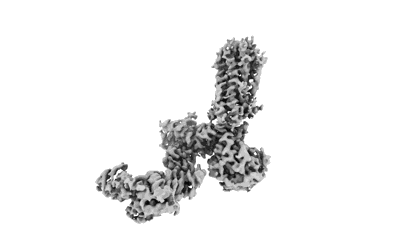EMD-36475
cryo-EM structure of NTSR1-GRK2-Galpha(q) complexes 2
EMD-36475
Single-particle3.07 Å
 Deposition: 11/06/2023
Deposition: 11/06/2023Map released: 09/08/2023
Last modified: 06/11/2024
Sample Organism:
Homo sapiens,
synthetic construct,
Bos taurus
Sample: NTSR1-GRK2-Galpha(q) complexes 2
Fitted models: 8jpc (Avg. Q-score: 0.458)
Deposition Authors: Duan J ,
Liu H,
Zhao F,
Yuan Q,
Ji Y,
Xu HE
,
Liu H,
Zhao F,
Yuan Q,
Ji Y,
Xu HE 
Sample: NTSR1-GRK2-Galpha(q) complexes 2
Fitted models: 8jpc (Avg. Q-score: 0.458)
Deposition Authors: Duan J
 ,
Liu H,
Zhao F,
Yuan Q,
Ji Y,
Xu HE
,
Liu H,
Zhao F,
Yuan Q,
Ji Y,
Xu HE 
GPCR activation and GRK2 assembly by a biased intracellular agonist.
Duan J  ,
Liu H,
Zhao F,
Yuan Q,
Ji Y,
Cai X,
He X
,
Liu H,
Zhao F,
Yuan Q,
Ji Y,
Cai X,
He X  ,
Li X,
Li J,
Wu K,
Gao T,
Zhu S,
Lin S,
Wang MW
,
Li X,
Li J,
Wu K,
Gao T,
Zhu S,
Lin S,
Wang MW  ,
Cheng X
,
Cheng X  ,
Yin W
,
Yin W  ,
Jiang Y,
Yang D
,
Jiang Y,
Yang D  ,
Xu HE
,
Xu HE 
(2023) Nature , 620 , 676 - 681
 ,
Liu H,
Zhao F,
Yuan Q,
Ji Y,
Cai X,
He X
,
Liu H,
Zhao F,
Yuan Q,
Ji Y,
Cai X,
He X  ,
Li X,
Li J,
Wu K,
Gao T,
Zhu S,
Lin S,
Wang MW
,
Li X,
Li J,
Wu K,
Gao T,
Zhu S,
Lin S,
Wang MW  ,
Cheng X
,
Cheng X  ,
Yin W
,
Yin W  ,
Jiang Y,
Yang D
,
Jiang Y,
Yang D  ,
Xu HE
,
Xu HE 
(2023) Nature , 620 , 676 - 681
Abstract:
Phosphorylation of G-protein-coupled receptors (GPCRs) by GPCR kinases (GRKs) desensitizes G-protein signalling and promotes arrestin signalling, which is also modulated by biased ligands1-6. The molecular assembly of GRKs on GPCRs and the basis of GRK-mediated biased signalling remain largely unknown owing to the weak GPCR-GRK interactions. Here we report the complex structure of neurotensin receptor 1 (NTSR1) bound to GRK2, Gαq and the arrestin-biased ligand SBI-5537. The density map reveals the arrangement of the intact GRK2 with the receptor, with the N-terminal helix of GRK2 docking into the open cytoplasmic pocket formed by the outward movement of the receptor transmembrane helix 6, analogous to the binding of the G protein to the receptor. SBI-553 binds at the interface between GRK2 and NTSR1 to enhance GRK2 binding. The binding mode of SBI-553 is compatible with arrestin binding but clashes with the binding of Gαq protein, thus providing a mechanism for its arrestin-biased signalling capability. In sum, our structure provides a rational model for understanding the details of GPCR-GRK interactions and GRK2-mediated biased signalling.
Phosphorylation of G-protein-coupled receptors (GPCRs) by GPCR kinases (GRKs) desensitizes G-protein signalling and promotes arrestin signalling, which is also modulated by biased ligands1-6. The molecular assembly of GRKs on GPCRs and the basis of GRK-mediated biased signalling remain largely unknown owing to the weak GPCR-GRK interactions. Here we report the complex structure of neurotensin receptor 1 (NTSR1) bound to GRK2, Gαq and the arrestin-biased ligand SBI-5537. The density map reveals the arrangement of the intact GRK2 with the receptor, with the N-terminal helix of GRK2 docking into the open cytoplasmic pocket formed by the outward movement of the receptor transmembrane helix 6, analogous to the binding of the G protein to the receptor. SBI-553 binds at the interface between GRK2 and NTSR1 to enhance GRK2 binding. The binding mode of SBI-553 is compatible with arrestin binding but clashes with the binding of Gαq protein, thus providing a mechanism for its arrestin-biased signalling capability. In sum, our structure provides a rational model for understanding the details of GPCR-GRK interactions and GRK2-mediated biased signalling.
